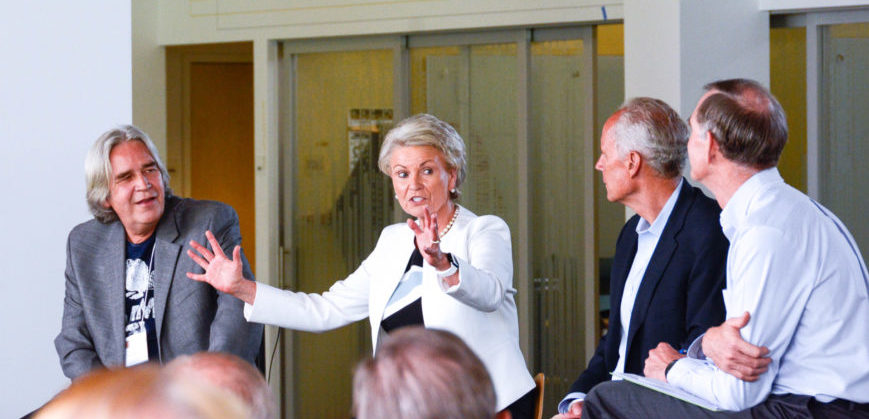
Speakers at the Western Water Symposium — from left, DC Jackson, Pat Mulroy, Jim Lochhead and Brad Udall — came together to wrap up the presentations with an interactive panel discussion, July 25. Photo by Terry Nash
The politics of water in the West was the theme of the second annual Western Water Symposium, held at the end of July at Morgan Library on the Colorado State University campus. More than 130 attendees heard from a series of water experts that the politics of water in the West transcends party affiliation — and there’s probably not a more divisive issue, even in this election year.
Among the speakers was Pat Mulroy, senior fellow at the William S. Boyd School of Law at the University of Nevada Las Vegas, who said the federal regulatory system of water management in the West is “broken.” Mulroy said leadership and creative solutions are needed to “reform the federal regulatory rigidity.”
She focused much of her talk on the Lower Colorado River Basin, which stretches through Nevada and Arizona – and forms Lakes Mead and Powell – before running into southern California and supplying the thirsty Los Angeles and San Diego markets. Mulroy said it would be necessary for those in the Lower Colorado River Basin to “redefine their relationship to water, and do more with less in the future.” Otherwise, she said there will be nothing for the region but “hydrologic leftovers.”
Action, not inaction
 Former Colorado U.S. Senator Hank Brown also addressed the gathering. Brown, who helped to negotiate the state’s only wild and scenic designation on the Cache La Poudre River west of Fort Collins, said the designation would not have come about had there not been compromises and the desire to develop a “great thing from action, not inaction.”
Former Colorado U.S. Senator Hank Brown also addressed the gathering. Brown, who helped to negotiate the state’s only wild and scenic designation on the Cache La Poudre River west of Fort Collins, said the designation would not have come about had there not been compromises and the desire to develop a “great thing from action, not inaction.”
That inaction, according to Brown, comes at the federal level with numerous regulations, environmental impact statements and layers of bureaucracy. He said that the U.S. Army Corps of Engineers, the agency primarily responsible for overseeing approval of water projects, should change its focus because “doing away with water storage has nothing to do with controlling growth,” especially along the fast-growing Colorado Front Range.
Instead, Brown said that preparing for future growth and infill should be a task that the state and communities coordinate and work together on now, so that plans could be made for preserving open space, creating dedicated traffic corridors, and planning for additional water storage.
Water distribution is monolithic, linear
Colorado allocates its water through a complex scenario based on prior appropriation, decrees and interstate compacts. Jim Lochhead, CEO and manager of Denver Water, said the “first in time, first in right” approach creates some winners and some losers, and that the current system of distributing water in the West is “monolithic and linear, but politics is driving the system.” And that it will take “leadership to get past the ‘zero-sum game’ approach.”
Lochhead, like Brown, was wary of several federally enacted laws, such as the Endangered Species Act, Clean Air and Clean Water Acts, but said these regulations served as a wake-up call to the water community. Water providers, such as Denver Water, were seeing not only the prohibition of new projects, but limitations being placed on expansion of existing projects.
He said confrontation was replaced with community building, reaching out to local groups and communities to create a level of trust. Lochhead said that has resulted in better relations between urban and rural water interests, Western slope and Front Range providers, and upper basin and lower basin users.
The Western Water Symposium also featured D.C. Jackson, a noted professor of history at Lafayette College, who provided a glimpse into the integration of dam engineering in the West and politics during the 1920s.
Symposium benefits Water Resources Archive
The symposium benefits the Water Resources Archive, a joint effort between Morgan Library and Colorado Water Institute. The Archive centralizes historically important water-related collections, documenting the role that water has played in the development of Colorado and beyond. In all, more than 100 collections related to water resources throughout Colorado, the Western U.S., and from around the world are housed there, with about 5 percent of the total holdings available online at www.lib.colostate.edu/water.